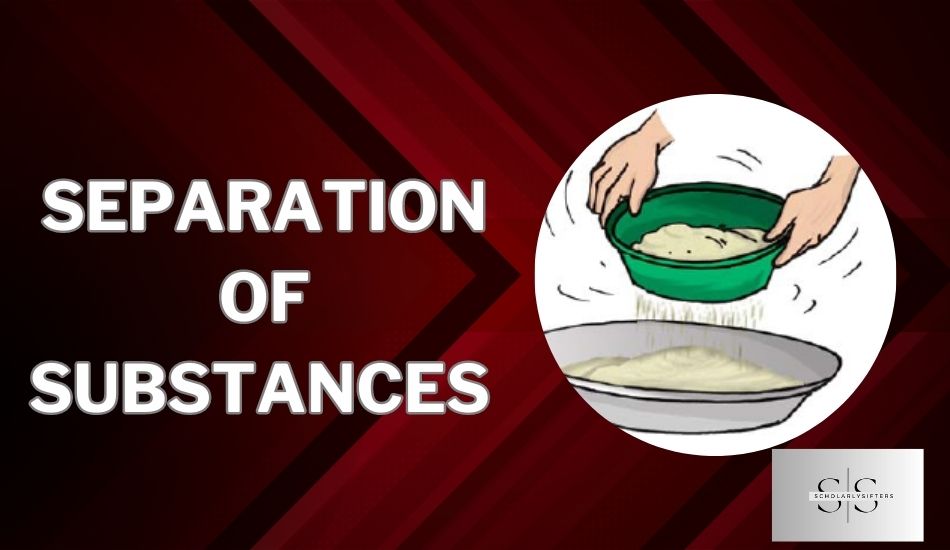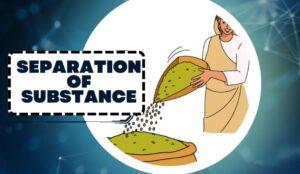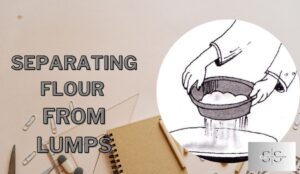No products in the cart.

Dividing Matter: The Art of Separation of Substances

Introduction
Separation of substances refers to the process of isolating or removing individual components from a mixture, which contains two or more different substances physically combined together. The objective of separation is to obtain the pure form of each component, allowing them to be utilized individually or for specific purposes.
Importance of Separation of Substances in our daily lives:
Purification:
Many substances found in nature or produced synthetically contain impurities. Separation processes allow the purification of substances, ensuring their safety, efficacy, and usability. For instance, water treatment facilities use separation techniques to purify water for domestic consumption.
Food and Agriculture:
In the food industry, separation techniques are used to extract essential nutrients, separate undesirable components, and improve the overall quality of food products. Agricultural practices also benefit from separation processes, as they enable the isolation of fertilizers, pesticides, and other essential compounds.
Healthcare:
Pharmaceutical industries rely heavily on separation techniques to obtain pure and potent drugs. The isolation and purification of active pharmaceutical ingredients (APIs) are crucial to ensure the effectiveness and safety of medications.
Recycling:
Separation of substances is crucial for recycling processes. It enables the segregation and recovery of valuable materials from waste products, reducing the environmental impact and conserving natural resources.
Environmental Protection:
Separation techniques play a vital role in treating pollutants and harmful substances from wastewater and industrial effluents before releasing them into the environment. This helps in minimizing environmental contamination and maintaining ecological balance.
Chemical Industry:
The chemical industry extensively uses separation methods to extract desired products from complex mixtures, separating chemicals with specific properties for further processing and utilization.
Mining:
In mining operations, separation techniques are employed to extract valuable minerals from ore deposits, allowing for economic extraction and utilization of natural resources.
Analytical Techniques:
In scientific research and laboratory analysis, separation methods are essential for identifying and quantifying individual components within a mixture. Techniques like chromatography and distillation are widely used for analytical purposes.
Types of Substances
Mixtures
A mixture is a combination of two or more substances in which each component retains its individual properties and can be physically separated from the others. Unlike compounds, mixtures do not involve chemical bonding between the constituent substances.
Examples of Mixtures:
Saltwater:
A common example of a homogeneous mixture is saltwater, which is a combination of salt (sodium chloride) dissolved in water. Both components can be easily separated by processes like evaporation.
Air:
Air is a mixture of gases, primarily composed of nitrogen (about 78%), oxygen (about 21%), and traces of other gases like carbon dioxide, argon, and water vapor. Despite its composition, each gas maintains its own properties, and the mixture can be separated using techniques like fractional distillation.
Sand and Water:
This is an example of a heterogeneous mixture. When sand is mixed with water, it forms a mixture where the sand particles remain visibly distinct from the water. This can be separated by simple methods like filtration.
Compounds
A compound is a substance composed of two or more elements chemically bonded together in a fixed ratio. Unlike mixtures, compounds have distinct chemical properties that are different from the properties of their individual constituent elements.
Examples of Compounds:
Water (H2O):
One of the most familiar compounds, water is formed by the chemical bonding of two hydrogen atoms with one oxygen atom. It is essential for life and exists in liquid form at standard temperatures and pressures.
Table Salt (Sodium Chloride – NaCl):
Table salt is a compound formed by the combination of sodium (Na) and chlorine (Cl) atoms in a 1:1 ratio. It is commonly used as a seasoning and food preservative.
Carbon Dioxide (CO2):
Carbon dioxide is a compound composed of one carbon atom and two oxygen atoms. It is a naturally occurring gas and a significant component of the Earth’s atmosphere
Methods of separation of substances
Handpicking
Handpicking is one of the simplest methods of separation of substances, where substances are separated manually by using hands or tools.
Examples of when to use Handpicking:
Pebbles from sand:
Handpicking is commonly used to separate pebbles from sand. In this case, the pebbles are larger and can be easily distinguished by their size and shape, allowing them to be picked out by hand, leaving behind the fine sand particles.
Removing stones from grains:
Before cooking or grinding grains, such as rice or lentils, handpicking is used to remove any stones or foreign objects that may be present in the grains.
Sieving
Sieving is a separation of substances method used to separate particles based on their size. It involves passing a mixture through a sieve, which is a device with a mesh or perforated surface.
Examples of when to use Sieving:

Separating flour from lumps:
Sieving is commonly used in the kitchen to separate flour from lumps. When flour is stored for a long time, it may develop lumps due to moisture absorption.
Soil analysis:
In agricultural or environmental studies, sieving is used to analyse soil samples. The soil is passed through sieves of varying mesh sizes to separate particles of different sizes, which helps in determining soil texture and composition.
Filtration
Filtration is a separation technique used to separate a solid-liquid mixture by passing it through a porous medium, such as filter paper or a filter funnel. The solid particles are retained on the filter while the liquid, called the filtrate, passes through.
Examples of when to use Filtration:
Separating solid and liquid components: Filtration is commonly used to separate solid impurities from liquids.
For example, when brewing coffee, a paper filter is used to separate the coffee grounds from the liquid coffee.
Water purification:
Filtration is a crucial step in water treatment processes. Large-scale filtration systems remove suspended particles and impurities from water, making it safe for consumption.
Evaporation
Evaporation is a separation technique used to separate a solvent (usually a liquid) from a dissolved solid or other non-volatile substance. The process involves heating the mixture to convert the solvent into vapor, leaving behind the non-volatile solute or substance.
Examples of when to use Evaporation:
Separating salt from saltwater:
Evaporation is commonly used to separate salt from saltwater. When saltwater is heated, the water evaporates, leaving the salt behind. The water vapor can be condensed back into liquid form, resulting in pure water, while the salt remains as a solid residue.
Recovering dissolved substances:
Evaporation is also used to recover dissolved substances from a solution. For example, in the sugar industry, sugarcane juice is heated to evaporate the water, leaving behind crystallized sugar.
Magnetic Separation
Magnetic separation is a method used to separate magnetic materials from non-magnetic ones. It relies on the magnetic properties of certain substances. In this process, a magnet or magnetic separator is used to attract and separate the magnetic particles from a mixture. The non-magnetic particles remain unaffected and are left behind.
Examples of when to use Magnetic Separation:
Separating iron from sand:
Magnetic separation can be used to separate iron particles from a mixture of iron filings and sand. By using a magnet, the iron filings are attracted to it, leaving the sand behind.
Recycling applications:
Magnetic separation is widely used in recycling processes to separate ferromagnetic materials (e.g., iron, steel) from non-magnetic materials, aiding in the recycling of metals and other materials.
Distillation
Distillation is a separation process used to separate components of a liquid mixture based on their differences in boiling points. The mixture is heated to its boiling point, and the vapors produced are condensed back into liquid form and collected separately. The component with the lower boiling point vaporizes first and is collected as the distillate, while the higher boiling point component remains in the original container.
Examples of when to use Distillation:
Separating alcohol from water:
Distillation is commonly used to separate alcohol from water in the production of alcoholic beverages. Since alcohol has a lower boiling point than water, heating the mixture causes alcohol to vaporize first, leaving water behind. The alcohol vapor is then condensed back into liquid form, resulting in the distilled alcohol.
Purifying liquids:
Distillation is utilized in various industries to purify liquids and separate volatile components from non-volatile impurities.
Distillation is an essential technique in chemistry, the food and beverage industry, and various manufacturing processes where the separation of liquid components based on their boiling points is required.
Fun Experiments for Separation of Substances
Separating Ink Colours with Paper Chromatography:
Materials needed:
- Coffee filter paper or chromatography paper
- Water-soluble markers of different colours
- Tall glass or container
- Water
Procedure:
- Draw a small dot or line of each marker colour near the bottom edge of the coffee filter paper.
- Pour a small amount of water into the glass, about 1/4 full.
- Hang the paper vertically in the glass so that the tip of the paper is submerged in the water, but the ink marks are above the water level.
- Allow the water to slowly move up the paper through capillary action, carrying the ink with it.
- Observe how the ink separates into different colors as it moves up the paper.
- Once the water reaches the top of the paper or the ink has fully separated, remove the paper and let it dry.
 Conclusion
Conclusion
The separation of substances is essential in various aspects of our lives. It allows us to obtain pure materials, remove impurities, and manage resources efficiently. Separation processes play a crucial role in industries like food, pharmaceuticals, environmental protection, and recycling.
Handpicking: Separating components by hand based on their distinct physical properties.
Sieving: Separating particles based on their size using a mesh or perforated surface.
Filtration: Separating a solid-liquid mixture by passing it through a porous medium.
Evaporation: Separating a solvent from a dissolved solid or non-volatile substance by heating and vaporization.
Magnetic Separation: Separating magnetic materials from non-magnetic substances using a magnet or magnetic separator.
Distillation: Separating components of a liquid mixture based on their differences in boiling points.






